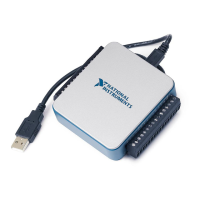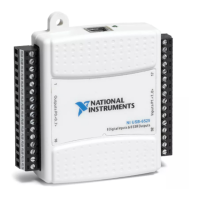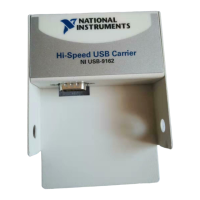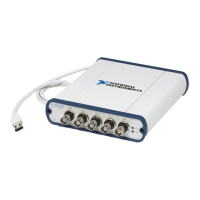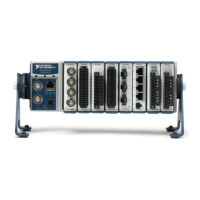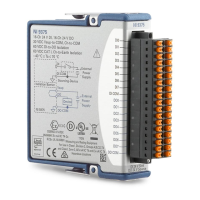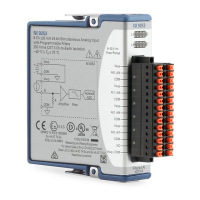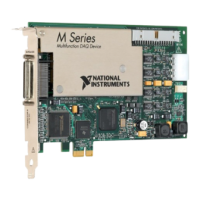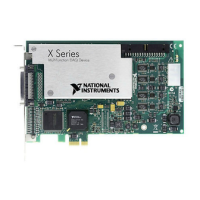20 | ni.com | NI USB-6001/6002/6003 User Guide
Minimizing Glitches on the Output Signal
When using a DAC to generate a waveform, you may observe glitches on the output signal.
These glitches are normal; when a DAC switches from one voltage to another, it produces
glitches due to released charges. The largest glitches occur when the most significant bit of the
DAC code changes. You can build a lowpass deglitching filter to remove some of these glitches,
depending on the frequency and nature of the output signal. Visit
ni.com/support for more
information about minimizing glitches.
Analog Output Data Generation Methods
When performing an analog output operation, you can perform software-timed or
hardware-timed generations:
• Software-Timed Generations—Software controls the rate at which data is generated.
Software sends a separate command to the hardware to initiate each NI DAQ conversion.
In DAQmx, software-timed generations are referred to as on-demand timing.
Software-timed generations are also referred to as immediate or static operations. They are
typically used for writing a single value out, such as a constant DC voltage.
• Hardware-Timed Generations—A digital hardware signal controls the generation rate.
This signal is generated internally on your device. Hardware-timed generations have
several advantages over software-timed acquisitions:
– The time between samples can be much shorter.
– The timing between samples can be deterministic.
Hardware-timed operations are buffered. During hardware-timed AO generation, data is moved
from a PC buffer to the onboard FIFO on the NI DAQ device using USB signal streams before
it is written to the DACs one sample at a time. Buffered generations allow for fast transfer rates
because data is moved in large blocks rather than one point at a time.
One property of buffered I/O operations is the sample mode. The sample mode can be either
finite or continuous:
• Finite sample mode generation refers to the generation of a specific, predetermined number
of data samples. After the specified number of samples is written out, the generation stops.
• Continuous generation refers to the generation of an unspecified number of samples.
Instead of generating a set number of data samples and stopping, a continuous generation
continues until you stop the generation.
AO Start Trigger
You can configure PFI 1 or PFI 0 as the AO Start Trigger for analog output tasks. Refer to the
Using PFI to Trigger an Analog Output Generation section for more information.

